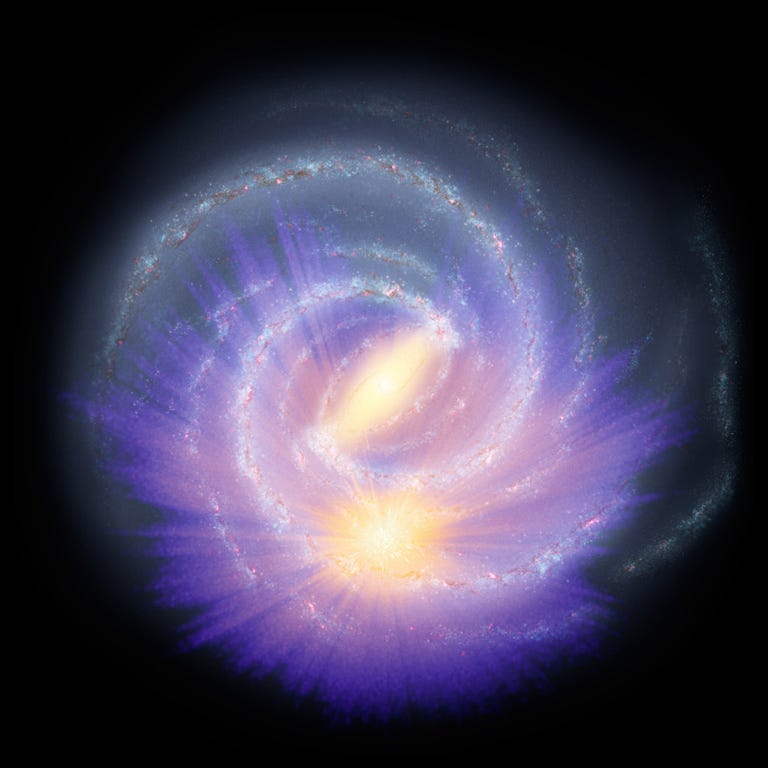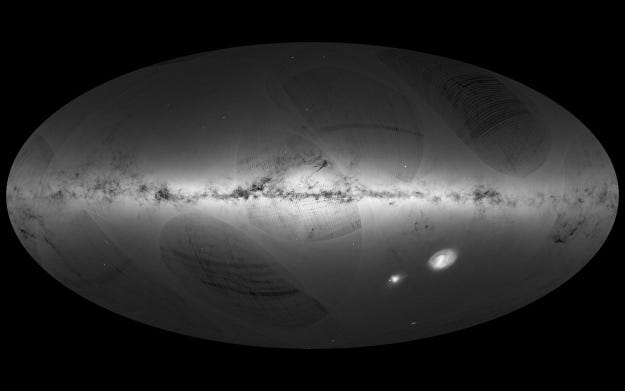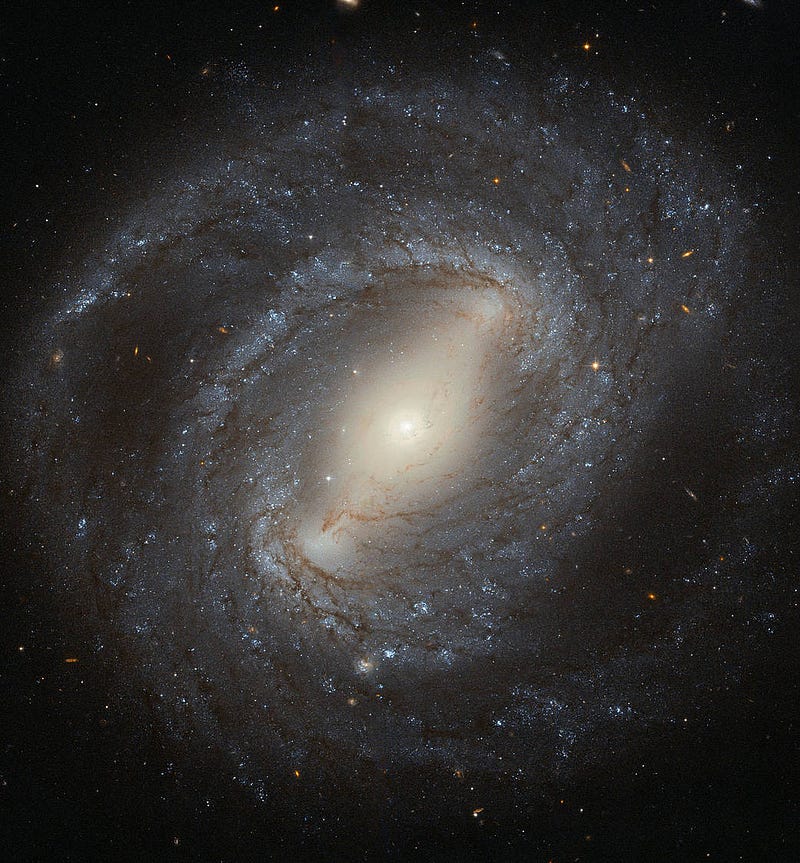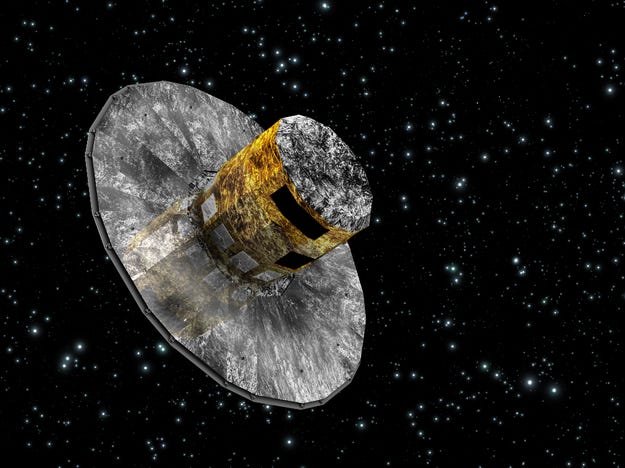Exploring the Hidden Bar of the Milky Way Revealed by Gaia
Written on
Chapter 1: Unveiling the Milky Way's Structure
The Milky Way galaxy, our celestial home, is categorized as a barred spiral galaxy, harboring an astonishing number of stars—estimated in the hundreds of billions. This vast family of stellar systems spans a disk that measures approximately 100,000 light years in diameter and around 1,000 light years in thickness.
The Gaia space telescope, a mission by the European Space Agency (ESA) launched on December 19, 2013, was specifically designed to create a three-dimensional map of stars within the Milky Way and beyond. Recently, astronomers utilized this groundbreaking instrument to unveil the bar at the center of our galaxy for the first time, marking a significant step toward answering fundamental questions regarding the galaxy's formation and evolution.

The image depicts a color chart overlaid on an artistic illustration of the Milky Way, showcasing the distribution of 150 million stars based on data collected by the Gaia telescope. The position of our Sun is highlighted in yellow, situated near the bottom-center of the depiction. Image credit: ESA/Gaia/DPAC, A. Khalatyan (AIP) & StarHorse Team; artistic map of the Galaxy: NASA/JPL-Caltech/R. Hurt (SSC/Caltech)
Researchers compare the current state of galactic astrophysics to the geography of the 15th century, where large sections of Earth remained undiscovered, and only rudimentary maps existed. They noted that while significant areas of the Milky Way are still obscured by dense dust, advancements in large photometric, astrometric, and spectroscopic surveys are improving our ability to explore and map our galaxy with greater accuracy, as detailed in a journal article published in Astronomy and Astrophysics.

The first star density map produced by Gaia in 2016. Image credit: ESA/Gaia/DPAC
The second data release from Gaia in 2018 encompassed the initial 22 months of observations and included information on over one billion stars within and beyond our galaxy. This data, combined with infrared and optical information from terrestrial telescopes, provided a groundbreaking view of the bar located at the core of our galaxy.
“Thanks to the second Gaia data release, we were able to explore a radius around the Sun of approximately 6,500 light years. However, with our new catalogue, we can extend this ‘Gaia sphere’ three to four times further, reaching towards the heart of the Milky Way,” stated Cristina Chiappini from the Leibniz Institute for Astrophysics Potsdam in Germany (AIP). The data from Gaia was integrated with observations from other telescopes using a computer program called Starhorse, led by Anna Queiroz from AIP.

A view of the barred spiral galaxy NGC 4394, captured by the Hubble Space Telescope, which resembles our own galaxy from an external perspective. Image credit: ESA/Hubble & NASA, Acknowledgement: Judy Schmidt
Section 1.1: The Search for the Galactic Bar
For years, astronomers have theorized that the Milky Way is structured as a barred spiral. Previous data supporting this notion came from the analysis of star and gas movements, in addition to star counts from infrared studies. Dense clouds of dust obstruct our view of the galactic center in visible light, but infrared observations penetrate this haze more effectively, allowing astronomers to see beyond the obscured regions.
Much like a city made up of distinct neighborhoods, the Milky Way consists of various areas, each with unique features. The Gaia telescope aims to enable researchers to map these different regions and gain a deeper understanding of their origins. Among these areas is the newly identified bar at the galaxy's center, which has never been measured before.
“It remains uncertain how the bar—a large grouping of stars and gas rotating around the galaxy’s center—was formed, but with Gaia and future surveys, we are certainly on the right path to uncovering this mystery,” Cristina added. Stars form from the gas and dust found in interstellar space, incorporating local materials. Upon their demise, these stars release materials that contribute to the birth of new stellar generations.

An artist’s rendition of the Gaia telescope in space. Image credit: ESA
Section 1.2: The Future of Gaia's Discoveries
The third data release from Gaia is anticipated in 2021 and is likely to provide more detailed information about the distances of numerous stars, potentially revealing new insights about the center of the Milky Way.
Gaia is projected to identify between 10,000 and 50,000 exoplanets orbiting other stars, including all Jupiter-sized planets within 150 light years of the Sun with orbital periods ranging from 1.5 to nine years. Currently, astronomers have confirmed just over 4,000 exoplanets, with thousands more awaiting validation.
Additionally, brown dwarfs—failed stars that are several times larger than Jupiter—are thought to orbit other stars. However, astronomers have not discovered as many of these objects as expected, a phenomenon known as the "Brown Dwarf Desert." Gaia is expected to uncover tens of thousands of these elusive stars that never reached full size.
Gaia is also on a mission to identify asteroids and comets within our solar system, and over the course of its mission, it is anticipated to observe hundreds of thousands of these bodies, ranging from near the Sun to the far reaches of the solar system.
In addition to searching for planets, asteroids, and comets, Gaia is expected to observe as many as 100,000 supernovae throughout its operational life. Since measuring the peak brightness of these explosions is crucial for determining their distance, the Gaia telescope is ideally suited for studying these extraordinary events.

Supernova Gaia14aaa, shown alongside its host galaxy in September 2014. The left image captures the supernova and galaxy together, while the middle image displays the galaxy before the explosion. By subtracting the second image from the first, astronomers can isolate the supernova itself (right). Image credit: M. Fraser et al.
This telescope will conduct some of the most intricate studies of key astrophysical theories ever attempted, including setting an upper limit on the strength of gravitational waves, a concept proposed by Albert Einstein over a century ago.
Gaia orbits the Sun at the L2 Lagrange point, located 1.5 million kilometers (932,000 miles) from Earth’s night side. This positioning allows Gaia to orbit the Sun alongside Earth, free from eclipses. The upcoming James Webb Space Telescope (JWST), the successor to Hubble, will also operate from this location.
In Greek mythology, the goddess Gaia symbolizes the Earth and was the first deity born from chaos (the void). Among her many offspring were Uranus (the Sky), Ourea (the Mountains), and Pontus (the Sea).
Mission engineers designed Gaia to function until at least 2022. During this period, the robotic observatory will observe one billion objects approximately 70 times each. Several additional datasets are scheduled for release in the upcoming years, enriching our understanding of the Milky Way's birth and evolution.
The first video, titled "The Merger History of the Milky Way – What Gaia Revealed with Eva Grebel," delves into the insights gained from Gaia's observations regarding the Milky Way's formation and history.
The second video, "Gaia's discovery of a massive black hole in our Milky Way: Gaia BH3 (long version - voice - music)," provides an in-depth look into Gaia's findings related to a significant black hole located within our galaxy.
Did you enjoy this article? Subscribe to The Cosmic Companion Newsletter!